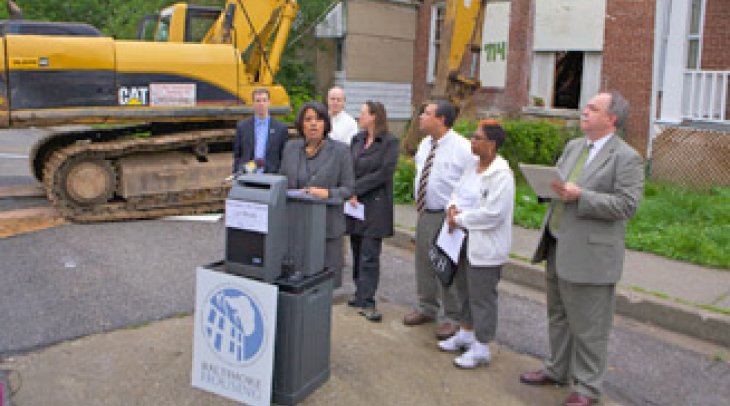Mayor Rawlings-Blake Leads First Vacants to Value Demolition
Wednesday May 18th, 2011

FOR IMMEDIATE RELEASE

34 Vacant homes to be demolished or rehabbed in Woodbourne/McCabe Community
Today, Mayor Rawlings-Blake was joined by Baltimore Housing Commissioner Paul Graziano, Councilman Bill Henry, and community partners for the first major Vacants to Value demolition event. Under the Mayor’s new Vacants to Value initiative, Baltimore Housing worked with community partners including the Woodbourne/McCabe Community Association, Neighborhood Housing Services (NHS) Baltimore, and Habitat for Humanity for the Chesapeake to devise a plan to purchase, demolish and redevelop 34 vacant properties in the Northeast Baltimore community.
Today, demolition began on five vacant, blighted properties in the Woodbourne/McCabe Community. NHS Baltimore and Habitat for Humanity of the Chesapeake will rehab 23 properties in the neighborhood over the next two years, while the remaining seven vacant properties will be either sold through tax sale foreclosure or addressed in an alternative strategy.
“This is Vacants to Value in action,” said Mayor Rawlings-Blake. “What you see here today is a big step forward to rid this community of blight and make Baltimore’s neighborhoods better, safer and stronger. This is a great example of how community partners can come together and make real progress on one of Baltimore’s toughest and most stubborn challenges.”
Announced last November, Vacants to Value is Mayor Rawlings-Blake’s comprehensive 6-point strategy to reduce blight. The initiative seeks to drive growth and reinvestment in Baltimore's neighborhoods by streamlining the sale of vacant city property; strengthening code enforcement efforts in transitional blocks and emerging markets to promote rehabilitation; and, by providing new, targeted incentives for homebuyers and developers who invest in vacant homes.
“Baltimore has suffered over 50 years of disinvestment and it is our neighborhoods that bear the cost,” said Commissioner Graziano. “Change will not take place overnight, but in time we anticipate even greater transformation that will encourage investment and facilitate growth in Baltimore’s neighborhoods.”